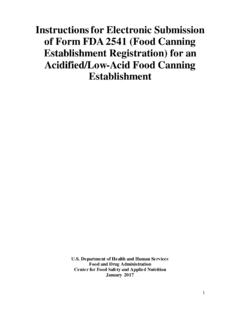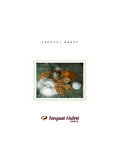Transcription of Recent developments in the tuna industry
1 543 ISSN 2070-7010 FAO FISHERIES AND AQUACULTURE TECHNICAL PAPER Recent developments in the tuna industryStocks, fisheries, management, processing, trade and markets Cover photograph: A tuna auction in Japan (courtesy of P. Miyake). Recent developments in the tuna industryStocks, fisheries, management, processing, trade and marketsbyMakoto Peter Miyake Visiting ScientistNational Research Institute of Far Seas FisheriesFisheries Research AgencyShimizu, JapanPatrice Guillotreau Principal Lecturer University of Nantes Nantes, France Chin-Hwa Sun Professor National Taiwan Ocean University Keelung, Taiwan Province of ChinaandGakushi Ishimura Assistant Professor Hokkaido University Sapporo, Japan FOOD AND AGRICULTURE ORGANIZATION OF THE UNITED NATIONSRome, 2010543 FAOFISHERIES ANDAQUACULTURETECHNICALPAPERThe designations employed and the presentation of material in this information product do not imply the expression of any opinion whatsoever on the part of the Food and Agriculture Organization of the United Nations (FAO)
2 Concerning the legal or development status of any country, territory, city or area or of its authorities, or concerning the delimitation of its frontiers or boundaries. The mention of specific companies or products of manufacturers, whether or not these have been patented, does not imply that these have been endorsed or recommended by FAO in preference to others of a similar nature that are not 978-92-5-106620-1 All rights reserved. FAO encourages reproduction and dissemination of material in this information product. Non-commercial uses will be authorized free of charge, upon request. Reproduction for resale or other commercial purposes, including educational purposes, may incur fees. Applications for permission to reproduce or disseminate FAO copyright materials, and all queries concerning rights and licences, should be addressed by e-mail to or to the Chief, Publishing Policy and Support Branch, Office of Knowledge Exchange, Research and Extension, FAO, Viale delle Terme di Caracalla, 00153 Rome, Italy.
3 FAO 2010iiiPreparation of this documentThe Fisheries and Aquaculture Resources Use and Conservation Division (FIR) of the Fisheries and Aquaculture Department of the Food and Agriculture Organization of the United Nations (FAO) is responsible for all programmes and activities relating to management and conservation of fisheries resources. This paper was prepared as part of the FIR work programme to enhance the understanding of the tuna industry , addressing the situation concerning tuna stocks, fisheries, management, processing, trade and markets. It provides an update of the earlier FAO Fisheries Technical Paper No. 467 (2004) on Historical trends of tuna catches in the world , extending it substantially into subjects not dealt with in that earlier paper was prepared under the direction of Jacek Majkowski, Senior Fishery Officer, Marine and Inland Fisheries Service, FIR.
4 The authors are: Dr Makoto Peter Miyake, Visiting Scientist at the National Research Institute of Far Seas Fisheries, Fisheries Research Agency, Japan; Dr Patrice Guillotreau, Visiting Researcher in Fisheries Economics at the Institut de Recherche pour le D veloppement (IRD) and Principal Lecturer at the University of Nantes, France; Dr Chin-Hwa Sun, Professor at National Taiwan Ocean University, Taiwan Province of China; and Dr Gakushi Ishimura, Assistant Professor at Hokkaido University, Japan. Dr Shelley Clarke, Visiting Researcher at Imperial College in London, United Kingdom, edited the paper. ivAbstractThis paper provides an updated review of world tuna fisheries. Previous studies (Miyake et al., 2004) discussed the historical development of tuna fisheries, described current world tuna fisheries, and explained the technological developments that have affected fishing operations.
5 The current paper expands the discussion to include socio-economic aspects of the tuna industry as a whole, specifically including Recent changes in processing, trade, marketing and consumer preferences. The first half of the paper introduces the conditions under which the studies were made and the data sources. It first provides caveats and assumptions which are designed to prevent misunderstanding or misinterpretation when using the data. It then reviews the world tuna stock status based on the results of Regional Fisheries Management Organizations (RFMOs) scientific reviews. Even though the biomass of most of the world s tuna stocks is generally above but close to the reference point, for a few stocks fishing mortality is above the maximum sustainable yield level indicating that the stock is being overfished. World tuna fisheries (mostly longline, purse seine and baitboat [pole-and-line] fisheries) are reviewed from the standpoint of catches, technological developments and economics.
6 Finally, tuna management measures taken by RFMOs are reviewed, including those used to mitigate bycatch. Gear and species interactions are specifically discussed in terms of allocations of the stocks between fisheries. The second half of the paper analyses tuna trade, processing, markets, consumption, price and profits for sashimi, fresh tuna steak, katsuobushi (dried skipjack stick) and canned tuna. The marketing of sashimi has changed very substantially from an exclusive Japanese market to a global one. The marketing system is also changing, because instead of being sold in market auctions, entire catches are now bought by one dealer and sold to large supermarkets or other retailers. This trend has had a clear impact on price and has resulted in the reduction of landing values. In the fresh and frozen steak tuna industry , in general, the price of tuna per unit weight is far higher than for canned materials.
7 Since the 1960s, the production of, and demand and market for, canned tuna has increased very rapidly, accompanied by the rapid development of purse seine fisheries in tropical waters. The largest consumer of canned tuna in the 1970s was by far the United States of America, but these levels have been exceeded by European Union markets in the last two decades. The relative importance of the major markets (the United States, the European Union and Japan) has been continuously declining as a percentage of the world market. These trends have been accompanied by the concentration of capital. Another major change has involved the relocation of tuna factories from developed countries to areas closer to raw materials. This also helped the industry by cutting labour and transshipment costs, and facilitated flexible export marketing. Production was formerly dominated by the United States but as production has declined, Thailand has become the top producer in the late 1990s, followed by Spain, as a result of newly developed canning materials in the form of loins.
8 In conclusion, because of the Recent rapid increase in competition among fisheries, species, industries and even products (sashimi/fresh tuna vs. canned), the most important and most urgent issue is how to manage and allocate tuna resources among these competitors ( using fishing capacity control measures and/or catch allocations). In order to achieve such an objective it is imperative that socio-economic and ecological considerations are integrated into decision-making processes alongside capacity and vallocation issues. This study does not address the broad socio-economic importance of the tuna industry to the countries in which it operates, but this type of research will be necessary in future in order to solve current fishery management problems. Miyake, M.; Guillotreau, P.; Sun, C-H; Ishimura, G. Recent developments in the tuna industry : stocks, fisheries, management, processing, trade and Fisheries and Aquaculture Technical Paper.
9 No. 543. Rome, FAO. 2010. of this document iiiAbstract ivAcknowledgements xiiiAbbreviations and acronyms xivExecutive summary xvi1. Introduction 12. Definitions and sources 33. Tuna stock conditions and scientific recommendations Definitions Atlantic Ocean Pacific Ocean Indian Ocean 94. Fisheries Overview of the world s tuna fisheries Catch data sources and uncertainties Trends in the world tuna catches Changes in fisheries primarily related to technological developments Historical changes and their causes General review of Recent changes Longline fisheries Baitboat fisheries Purse seine fisheries development of FADs and changes in target species Interactions between fishing gears and species The development of tuna farming Operating costs Fuel price Case study 1: Japanese distant water longline and baitboat fisheries Case study 2: Japanese offshore longline fleet Case study 3: Seychelles-based European purse seine fleet Case study 4.
10 Japanese distant-water purse seine fleet Comparisons of the balance between operating cost and revenue among various fleets 455. Management-related issues influencing tuna fisheries Management measures and compliance Atlantic Ocean Pacific Ocean Indian Ocean General management measures Fishing capacity IUU problems and trade measures Ecosystem considerations bycatch issues Sharks Sea turtles Seabirds Small tunas 596. Trade, processing, markets and consumption Data uncertainties in trade, processing and consumption Sashimi industry Some history and facts on sashimi culture Supplies for sashimi (or fresh fish market) Processing for sashimi Marketing system and price-making mechanism for sashimi products Sashimi consumption Sashimi markets Fresh tuna industry , including steak but excluding sashimi Fresh tuna consumption in Japan Fresh tuna consumption in Europe, including frozen products and sashimi Fresh tuna consumption in North America, including sashimi products Special skipjack products (katsuobushi and powders)


















